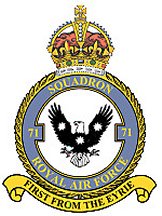
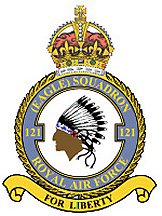
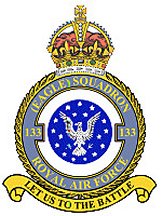 Overall, there were 243 American “Eagles” who flew in the
Eagle Squadrons. The first squadron, 71 was formed on 19 September 1940
and was followed by 121 Squadron the following May with the final squadron,
133 formed that August. Together the three Eagle Squadrons during the 18
months they existed were credited with 73.5 German aircraft destroyed with
a loss of 77 pilots. In September 1942, the three squadrons were disbanded
and many of the pilots formed the nucleus of the Fourth Fighter Group,
one of the top scoring US groups.
Overall, there were 243 American “Eagles” who flew in the
Eagle Squadrons. The first squadron, 71 was formed on 19 September 1940
and was followed by 121 Squadron the following May with the final squadron,
133 formed that August. Together the three Eagle Squadrons during the 18
months they existed were credited with 73.5 German aircraft destroyed with
a loss of 77 pilots. In September 1942, the three squadrons were disbanded
and many of the pilots formed the nucleus of the Fourth Fighter Group,
one of the top scoring US groups.
The Eagle Squadrons: Yanks in the RAF 1940-42.
Vern Haugland, Ziff-Davis Flying Books, New York, 1979
ISBN 0-87165-028-2
New hard cover in good condition, copies may be purchased
from Paul E. Kisselburg kmbooks@earthlink.net
Kisselburg Military Books
12195 126th St. N.
Stillwater, MN 55082
651-430-9223
Price - $30.00 US plus postage.
UK readers may obtain this book from:
Aardvark Books , 50 Bratton Road, Westbury, Wiltshire,
BA13 3EP, UK
Tel/ Fax: +44 (0)1225 867723
Email: aardvarkbooks@blueyonder.co.uk
The book is about American pilots who, from 1939 to December
1941, travelled to England to join the RAF, or came to Canada to be automatically
given the rank of P/O and, depending on their flying experience,
put on a transport for England. Much padding of logbooks and flying school
training information was done to ensure a direct trip to the UK.
This exodus of young American pilots was encouraged by
the recruiting efforts of Charles Sweeny, a prominent, well-heeled American
sportsman. The Sweeny project gave way to a larger, better organized, program
set up by the RCAF. A recruiting committee was set up in Ottawa and New
York City under the command of Air Vice Marshall Billy Bishop, Canada’s
leading air ace in WW1. Bishop’s Lieutenants consisted of an American flying
colleague, Clayton Knight, Rochester, New York, a military artist and magazine
illustrator, to be in charge of recruiting, and a Canadian, Homer Smith,
a cousin of Charles Sweeney, was made a Wing Commander in the RCAF as Administrator
for the recruiting program in the U.S.A.
All this might sound reasonable however, the U.S.A was
trying to project a neutral status to the point they passed the Neutrality
Act, which made going to Canada to enlist a criminal offence. This turned
Bishop’s recruiting activities into a clandestine, underground operation,
although much of their relationship with the American administration was
on a nod, nod, wink, wink, basis. At this time American Lend-lease aircraft
were being flown to the USA/Canadian border and hauled across the boarder
into Canada by tractors or teams of horses so as not to violate the act.
However, to enforce the Act, the American Government placed
CIA men in Canadian railway stations within the proximity of the Canada/US
boarder. These agents watched for young men coming to Canada to enlist
and gave them the option of returning voluntarily to the U.S. or be arrested
and taken back forcibly. Many flyers tried numerous rail lines into Canada
before succeeding. It was also found more successful to travel individually
rather than in groups. Some entered Canada under the guise of Red Cross
Workers.
The book goes into great detain on the operational history
of each Squadron giving in depth accounts of Pilots experiences.
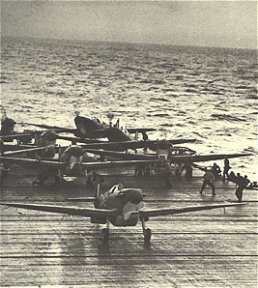
Eagle pilots taking their Spitfires off for Malta
from the deck of the U.S.S. Wasp in the Mediterranean.
These aircraft were vital to Malta’s defence.
Those of us who served in the RCAF, in a “Yes Sir, No
Sir, follow orders without question” environment, will be amazed at the
route one American took to Eagle Squadron 121.
Hubert “Bert” Stewart, from Raleigh North Carolina, rushed
up to Ottawa in 1939 to join the RCAF. He presented his “doctored” logbook
but was told he would have to give up his American citizenship and swear
allegiance to the Crown if he wanted to join the RCAF. He returned home.
In May 1940 he heard that the rules had changed and he need only promise
to obey the Canadian Government. So he went to Ottawa and enlisted as a
Sergeant pilot.
Bert went to Camp Borden, Ont. and started training in
single engine aircraft. On graduation he heard that if he had Instructor
status he would have a better chance of getting on an Eagle Squadron. He
was given orders to report to Moncton, New Brunswick for instructor training
on twin engine aircraft. Before he left for Moncton an instructor
told him that if he took that course he would be training pilots in Canada
for the rest of the war. Stewart protested to the Commanding Officer to
no avail.
At the railway station he met two American Pilots, who
had been accepted as RAF Pilot Officers, on their way to Halifax and overseas.
Stewart decided to go along with them.
The trip to Halifax and embarkation went smoothly mainly
because of the inefficiency of the embarkation officials.
In England Stewart accompanied the RAF group to its quarters
at Uxbridge, near London. He didn’t report in but lagged back and then
decided to go to London. At the US Embassy he asked what could be done
to a U.S. citizen in England without authority. He was told that he could
be deported to the United Sates.
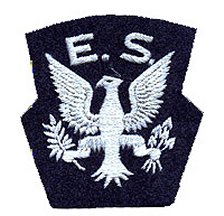 He
returned to Uxbridge and told the Adjutant his problem. He was taken before
the Commanding Officer, a World War 1 Pilot, Wing Commander Castings, who
turned out to be sympathetic. The CO sent the young American to a friend’s
house until the matter could be sorted out. Three days later Stewart was
posted to RAF Operational Training Unit at Sutton Bridge. Completing
the course with above average marks he was sent to a newly established
Eagle Squadron, No. 121.
He
returned to Uxbridge and told the Adjutant his problem. He was taken before
the Commanding Officer, a World War 1 Pilot, Wing Commander Castings, who
turned out to be sympathetic. The CO sent the young American to a friend’s
house until the matter could be sorted out. Three days later Stewart was
posted to RAF Operational Training Unit at Sutton Bridge. Completing
the course with above average marks he was sent to a newly established
Eagle Squadron, No. 121.
Some of our Ex-Air Gunners
Association’s American Members
Another American who came up to join the RCAF as an Air
Gunner and became
a member of our Ex-Air Gunner’s Association, was Lucien
Thomas. Here is Lucien’s story that appeared in Short Bursts Issue #35,
September 1991.
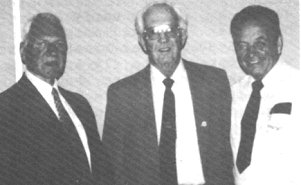
L to R: Lucien Tomas AG 405 Sqdrn,
Larry Sutherland AG 207 Sqdrn.
Francis Surovick, Korean Veteran
at the USAF Air Gunner’s Memorial
Dedication 1991.
I flew with 405 Squadron in 1942/1943 and have always
had a special place in my heart for the RCAF, Canadians, and all aircrew
members who flew with Bomber Command. Although I flew seven tours, ** the
RCAF seems to live in my memory as the happiest days of my life.
(** Lucien served in the RCAF, (DFM), the USAF, In
Guam, Korea, and Viet Nam.)
I want to thank you (Short Bursts) for printing the notice
of the USAF Air Gunner’s Memorial that was dedicated in May 1991. We were
honoured to have several Members of the Ex-Ags from Canada in attendance.
They made a terrific impression on everyone and at the dinner following
the dedication ceremony I wore a blazer with a 405 Squadron crest. A couple
of Americans, pointing at the insignia, asked me what was going on. I commented,
‘after seeing them’, I said, pointing to the well turned out Canadians,
‘I decided to transfer back to the RCAF.’
In the interlude between the Second World War and the
Korean War I served as an air gunner aboard heavy bombers with the 19th
bomber group on Guam and with the Strategic Air Command. When the Communists
invaded South Korea I was determined to go there. My efforts were in vain
until a friend who worked in the Pentagon miraculously brushed aside all
red tape and objections.
In early 1951 I found myself assigned to a Douglas B-26
Invader Unit in Miho, Japan. The B-26, designed as a low-level attack bomber
was equipped with two remotely controlled gun turrets. The upper turret
was mounted on the top of the fuselage above the bomb bay. The lower turret,
used exclusively for ground strafing, was mounted on the underside of the
aircraft. In addition to the 6 to 8 .50 calibre fixed guns in the nose,
there were 6 .50 calibre guns in the wings and rocket rails. The aircraft
carried a crew of three, Pilot and Navigator up front side by side and
the gunner in a compartment in the rear.
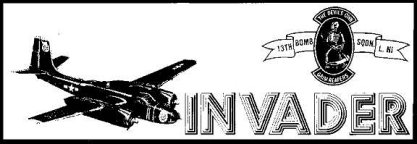
The remote control turrets were operated through a periscope
type gun sight. The Gunner occupied a bicycle type seat. A heavy duty four
inch lap belt was all that held him in position. As the Gunner sat towards
the rear of the aircraft, he was subject to twice the G force of the Pilot
and Navigator. Unlike most gunnery systems that were designed as defensive
weapons, the Invader systems were designed for offensive action. Special
talent was required to operate the gun switches when the aircraft was in
a steep turns at high speeds and low altitudes.
In the spring of 1952, we were up on Mig Alley following
the main rail line North from Chonju to Siniuju. Wolf spotted a tell tale
plume of a locomotive: “he’s heading for the tunnel around the bend in
the track…there’s a trestle a couple of miles from the entrance…we’ll take
that out first….then we’ll work him over.”
He lined up at a 45 degree angle to the rail line and
as the trestle disappeared under the nose of the Intruder, he released
a parademo. He dropped his left wing and glanced back for a confirming
look. He thought his eyes were deceiving him. A second train had emerged
from the tunnel and was heading in the direction of the trestle.
He swung the Invader around and came in from the other
direction. Light flak, some very accurate, emerged from the railroad right-of-way
and from a flat car on the second train. Wolf came in on the first locomotive
with all 14 forward guns firing, and just before he crossed over the locomotive
he released another parademo. After making a lazy-eight, he came in from
the opposite direction and dropped another parademo on the second locomotive.
He told me to try to clear out some of the light flak with my lower turret
and then proceeded to methodically dissect the locomotives and boxcars.
We called in a RB-26 reconnaissance Invader to take photos.
After they arrived we headed for home.” Photo Intelligence studied and
evaluated the photos the next day and we were credited with two locomotives,
28 boxcars, and a railroad trestle.”
In one of his books Lucien tells of crossing into North
Korea, which was contrary to orders, to do a low level attack on a Chinese
Mig field. It was a totally different war than he had experienced 1942
to 1945.
When the Viet Nam war came along Lucien did a number of
ops as a Munitions Officer. A real career Air Gunner and we were proud
to have him as a Member of our Association.
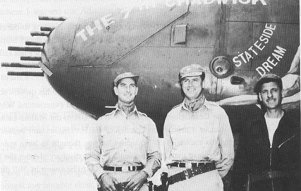
L to R: Austin Ayotte, Bob Lucadello, Lucien Thomas
With their B-26 “Hard Nose”
(Ed. I spoke with Lucien on the phone March 19, 2005,
He is alive and kicking and has written another book, “Never a Dull Moment”.
Some of this work deals with his time with 405 Squadron. I hope to review
this book in the May 2005 Newsletter.)
Bill “Yank” Poynter. Another American
in the RCAF
Bill had completed a tour with 69 Squadron, having got
his qualifications and training in Canada with the RCAF some miles from
his native USA. Bill was a skilled and experienced Wireless Air Gunner
and was pressed into service with the RAF helping to crew Beaufighters
in transit from the UK to the Middle East. He then took on the unusual
role in manning a machine gun in a motorized convoy of RAF vehicles and
personnel from Cairo to Habbaniyah in Iraq. When he completed his tour
with 69 Squadron he was thought to have volunteered for the Unite States
Army Air Corps (to this day he does not believe this), and suddenly, he
was discharged from the RCAF and the next thing he knew, was a terse demand
for him to get over to the US Army HQ’s to be sworn in. Bill did this and
became a Private! Now, let Bill tell the story.
Revenge is Sweet
“As a private I put up with a bunch of “loud mouth Americans,
with one very loud mouthed Corporal. This guy was a real jerk and I was
ready at any time to stomp him into the sand. Each morning very early,
this corporal would wake me up and I would have to clean out the inside
of the incinerator, take out all the cans and things that would not burn.
They were called ‘clinkers’. It was one lousy job, dirty, and besides,
this bastard would stick his head in and tell me what to pick up. Here
I was on my hands and knees with hardly enough room to move. This went
on until a date entered in my log book, June 1, 1943, when I was given
the rank of Staff Sergeant.
I was elated, not so much for myself, but what I was going
to do to that Corporal. I talked to the CO and he agreed that I would be
put in charge of the incinerator ‘clinker’ detail. First time he had received
such a request.
The Corporal came around at 6 am on June 2nd. and woke
me up for the ‘clinker’ detail. I got out of the sack with this silly bastard
standing there, and put on my new uniform. He was in a state of shock!
I told him that I was put in charge of the ‘clinker’ detail and, if he
wanted, he could check it out with the Duty Officer. Sure enough, he ran
to check it out.
I located him, ordered him to attention, and marched him
off to the incinerator. Some of his buddies came around and I ordered a
couple of them into the incinerator. Pretty soon there was a traffic jam
inside while I coolly walked around checking things.
On June 4th. /43, I was flown out to Heliopolis, Egypt
That Corporal and a couple of his buddies were sure elated to see me go.”
JOHN MOYLES
My first contact with American GI’s.
In the spring of 1942 an American troop ship destined
for Alaska, ran aground just South of Prince Rupert. All the troops had
to be taken off and billeted at the military bases in the area. Aircraft
were removed from our only hangar and the area filled with double deck
bunks. We already had some beds there as four crews had to be on “ready”
at all times, day or night, and we slept in the hangar. In fact, when we
first arrived, the barracks were still under construction so many of us
slept in the hangar. In the morning we had to wring the water out of our
blankets.
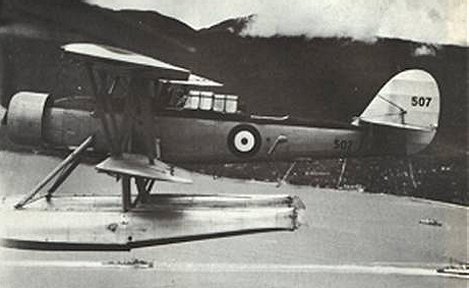
Blackburn Shark with Pilot and WAG – 7 BR Squadron
Prince Rupert
I had been on patrol the day the American troops moved
in. I came in from five hours sitting in an open cockpit of a Blackburn
Shark being blasted by slipstream and engine oil pellets, dirty, tired,
and just wanting to sack-out. To my amazement the hangar was full of noisy
American GIs and their gear.
I threw my parachute onto my bunk, shook off parachute
harness, flying boots, helmet, and crashed. Within seconds there was a
curious crowd peering down at me.
Questions started coming in rapid succession. “Where did
you fly,” “how far did you go”, “did you see any Japs?” etc, etc. Then
a young American said, “how long have you been in, when were you drafted?”
I said, “I wasn’t drafted, I joined voluntarily.” This
he found hard to believe. It was before Canada’s Conscription Legislation
so being drafted was foreign to me. The Americans stayed with us until
another troop ship arrived from the States.
An American Civilian came down from Ketchikan, Alaska,
to act as Liaison Officer during the American’s stay. This led to the first
time I set foot on American soil. The Liaison officer had a wife in Ketchikan
and he received a telegram saying that his wife was in labour in hospital.
Our Commanding Officer ordered Van, my Pilot, and myself, to fly the civilian
up to Ketchikan to visit his wife, and then bring him back to Prince Rupert.
Van was an American in the RCAF so he was quite excited
about drawing the flight. We landed at Ketchikan at low tide so Van cut
the engine outside the harbour. Before we left we had stowed a paddle and
I had to climb out onto the pontoon to paddle the aircraft past rocks and
obstructions. The dock, towered ten feet above the aircraft. We reached
the top by scaling a perpendicular wooden ladder.
There was a staff car waiting to rush the civilian to
the hospital and he told us to wait at the Cafe on the pier and then take
him back to Rupert. Van and I settled into the bar and he introduced me
to American Bourbon. The first one, compared to Teacher’s Highland Cream,
was pretty rough, but they got smoother as we waited.

Correct me if I’m wrong, but I think this was the
Bar on the wharf where I had my baptism to bourbon.
During
the war my passion was saving bar memorabilia.
The American returned to say his wife had blessed him
with a son and they were both doing fine. He then advised that his Department
had given him a week’s compassionate leave and he would not be returning
with us. Now we had to toast the father, and the mother, and the son –
the President, the King, and individual Sea Gulls perched on the pier.
By the time we were ready to leave the tide had come in
so we could step off the dock onto the pontoon. As a prairie boy the huge
tides always amazed me. Now, a number of bourbons on the ground are OK,
but when we got up to six thousand feet they really kicked in. We chatted
and laughed on the intercom. Van would shout, “hang on Moyles” and start
throwing the Shark all over the sky.
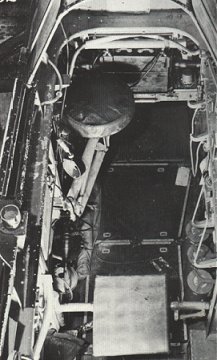
WAG’s cockpit with the seat in stowed position
In the open cockpit the Wireless Air Gunner was held in
by a canvas strap which was fastened to the floor of the cockpit by one
bolt and on the other end there was a large snap which was attached to
the D ring on the rear of the parachute harness. The WAG perched on a round
bar stool which swung out from the fuselage. It was alright as long as
one didn’t come down on the stool with the snap in the perpendicular position.
Van spotted some fishing boats and asked if I had anything
in my arsenal that I could toss out when we dive bombed them. I told him
that the aluminium sea markers would do the trick. Neither one of us was
feeling any pain. The aluminium markers were in 4” x 4” cardboard containers
designed to break open on impact and leave a large patch of aluminium on
the surface.
Down we went on the first vessel. I hung out over the
side fighting the slipstream, marker clutched in one hand and holding my
helmet on with the other, pressing the head phone into my ear so I could
hear Van’s command. He shouted “Now”. Marker released. The violent
pull-out feet above the vessel tested the safety strap to its limit. When
I recovered I saw the vessel spinning from our slipstream catching its
stabilizing sail, and a patch of aluminium floating off the ships bow.
After all, I was not a bomb aimer!
I must add that one of our first duties at 7 BR in early
’42 was to locate surface vessels, especially vessels that were running
from the West Coast, and notify the Canadian Navy.
It was dark when we arrived back at base and, as we had
no landing lights or flare path, Van used the shielded running lights of
ships moored in the bay. Nothing was ever heard of our shenanigans. I don’t
think I ever drank bourbon again.
Continuing the 7 BR Prince Rupert Theme
When eight Wireless Air Gunners and twelve Pilots arrived
in Seal Cove at Prince Rupert in December 1941 the Blackburn Sharks were
being delivered. A mountain was being blasted out to make room for hangar
sites and H type huts were under construction. On December 8, 1941,
the existing RCAF No.7 (Gp) General Purpose Squadron was re-named #7 Bomber
Reconnaissance Squadron. The day previous the Japanese Navy had attacked
Pearl Harbour.
Radio aids in the North West Pacific area were almost
nil so the CO decided we should build our own radio tower in the bush overlooking
the bay at Seal Cove. This Bay was the Blackburn Shark’s “runway” shared
by freighters, Naval ships, private vessels, flotsam and jetsam, and fishing
boats coming in to the local fish cannery.
And who would build this tower? Why who else, the masters
of all trades, the Wireless Air Gunners! P/O Hughs, a Pilot with some engineering
experience, ramroded the job. A square structure was erected on four pine
poles. In the tower there was a radio transmitter, receiver, aldis lamp,
very pistol, and binoculars. Not that traffic in the bay paid any attention
to our signals. Of course the WAGs had to man this tower around the clock.
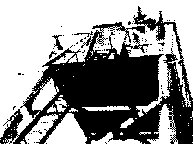
7 BR Radio Tower. Mel Livingstone, WAG, on duty
I enjoyed the night shift. Being in the tower at night
you felt completely cut off from the world. Due to weird radio signal skips
in the Northern areas, something to do with the atmospheric ionized layer
dropping at night, we could tune in Tokyo radio. We listen to Japanese
music and Tokyo Rose talking to the American GIs in the Pacific. It was
amazing how she would call them by name, unit, location, and even refer,
by name, to their loved ones at home, mothers, fathers, wives, girl friends.
It made one realize that the enemy had an efficient spy
system. I guess that is why the Japanese barbour and his wife whose shop
was just outside our main gate, suddenly disappeared, and their shop padlocked.
They were a nice couple and we used to patronize them.
To this day our time spent on top of those four poles
appears to have been an exercise in futility. The only time I fired the
very pistol was at a noisy raven, but he just hopped onto another branch
and continued to loudly protest my presence. I guess the project looked
good in the COs official report to Western Air Command HQ.
After Pearl Harbour a security blanket was dropped over
the West coast of North America. It was security to the point of paranoia.
At first we had two Sgt. Navigators on the Squadron but they had little
to do as they were not required in the Blackburn Sharks. One of the navigators
was honing his skills taking sun shots with his sextant. A Service Policeman
saw him and, thinking the instrument was a forbidden camera, confiscated
the sextant and marched the frustrated Navigator to the guardhouse where
cooler heads sorted things out.
A WAG took some pictures and sent them down to Vancouver
for developing. When the developer saw the photos he handed them over to
the military, and the dirt hit the fan!
It must be remembered there was no television with instant
news as today. Radio and newspapers only reported war news from Europe,
and this was heavily censored laced with propaganda. Read archive news
reports on Dieppe and you will find the media reported it as a great victory
for the Canadians. We were like mushrooms, kept in the dark and fed s—t.
One evening, Harold Penn, another WAG, and myself were
on “ready” duty in the hangar and, on the way to our bunks, we passed the
Flight Commander’s office. A voice called, “Come in here lads.” We entered
but it was not the Flight Commander, an officer with three rings on his
sleeve (no names, no pack drill) sat behind the desk. Between the in-basket
and the out-basket was an open bottle of rye and a .38 service revolver.
We came to attention and saluted. The Wing Commander put
us at ease, poured us drinks in paper cups, and proceeded to lecture us
on, “not to surrender to the enemy and not to be taken alive”. To emphasise
his point he picked up the revolver and said, “ there are six bullets in
this gun, the first five are for the enemy and the sixth one is for me.”
This man was a senior officer, approximately my father’s
age. He must have known what he was talking about. To a couple of nineteen
year old chaps, his word was almost gospel! After he dismissed us we lay
awake in our bunks wondering what was happening out there. How close were
the enemy – what did the Brass know that we didn’t? After all, hadn’t we
been ordered up to Prince Rupert before the “surprise attack” on Pearl
Harbour!
Then there was the CO who heard about enemy snipers tying
themselves in treetops.
He issued axes to every enlisted man on the Squadron
and ordered all trees within 200 yards cut down and fox holes dug and fortified.
The Medical Officer was kept busy patching up axe injuries. And who was
assigned to man these gun positions rain or shine? Yes you guessed it,
the Wireless Air Gunners! With an average annual rainfall of 125 inches,
this was not a comfortable assignment. On the night shifts, to make this
duty bearable, we would smuggle beer out to our fox holes. One of our WAGs
played a trumpet while on watch. But that is another story.
After the Japanese task force, commanded by Admiral Katuta,
consisting of 2 Carriers, the Ryujo and the Junyo, 2 heavy cruisers, 3
destroyers, backed up by a secondary force of 4 cruisers, 9 destroyers,
a screen of submarines, and 3 transports carrying 2500 invasion troops,
attacked Dutch Harbour in the Aleutians, on June 2, 1942, it was discovered
that this attack was a diversion and the main Enemy force was steaming
South East towards Midway.
We were not briefed that this had happened. On June 8,
1942, twelve Sharks were scrambled, we didn’t know why, with orders to
patrol West as far as fuel load would permit. Years later I read the book
TRINITY by Leon Uris, which explains the Japanese Naval tactics at that
time.
“Our’s was not to reason why,
Our’s was but to do and ….”
As the conflict moved South, many of the emergency measures
for the North West Coastal defences were eased. Naval patrols and air patrols
continued, all ocean-going vessels were challenged with the signal of the
day, identified and recorded. Submarine sightings were investigated, including
a Shark attack on a submarine off Rose Point, Queen Charlotte Islands,
on October 27, 1942 . Coastal artillery and anti-aircraft gunnery practice
continued. Blackouts were lifted, radio tower and fox holes remained but
were not manned. The Navy continued to secure the harbour every night with
submarine nets.
One night six WAGs and one Navigator, (all Flt/Sgts) in
our one-lunger boat, “The Little Flight”, were returning from a freshwater
swimming hole on an island. Due to engine failure, the Navy caught us adrift
outside the nets – but that is another story.
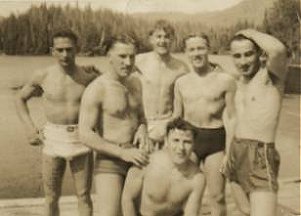
|
Back row – Baum, Diakow,
Centre – Evans, Penn, Leonty,
Front – Stern ,
at our secret swimming hole.
Hy Baum and Pilot Hal Phillips, were
killed in the crash of Shark 524
June 20, 1942. |
CORRESPONDENCE
Hello Don,
Just received the latest e-mail copy of Short Bursts from
John Moyles, in which you are seeking information about the Burma Hump
exploits of 435/436 squadrons.
I recently came across this site - www.rcaf.com/1939_1945_waryears/
- and thought I would send you this URL in the event that it may be useful.
It has many links which I have not had occasion to view and, therefore,
trust that you will find it helpful.
For John: Thanks for the latest copy of Short
Bursts - Greetings to Doreen from both Carol and I - and keep the Short
Bursts coming, I really do enjoy them.
Good luck in your endeavour Don.
Regards
Jack deBellefeuille
Pat O’buck
Plains, Montana, USA.
Very interesting issue, John. My John
was interested in the picture of the DC-3 (C47) which is the aircraft he
flew. However, he was not in the AF in WW II but transferred for
flight school during the Korean War. When he saw the picture he said,
"Oh, a C47!"
I had a lot of bucket seat time in those when I
was at Goose Air Base in Labrador in 1951-54. I was the civilian
Civilian Personnel Officer there working for the USAF (Goose was not a
"base for destroyers" and the U.S. had to hire Canucks.) I
was the only gal on the base then on officer status. I was going
out on a recruiting trip one time and a Lt. Colonel was waiting to get
on the plane. When they called for passenger loading, my name was
first and I overheard the Colonel say, "They treat her like a God Damned
Vip!!!"
Another time I was going back to Goose from Pepperell
AFB (St. John's) and there had been one heck of a party the night before.
The crew took me to a bunk up forward to lie down. When I awakened
I was dying of the heat. Seems the crew kept piling blankets on me
thinking I might be cold. Those guys were always great when I traveled,
always the only woman aboard. A crew member would stand guard if
I had to use the "bathroom," and I'd be asked several times on a
flight if I needed someone to stand guard. Because I was on officer
status, so indicated in my travel orders, the people at St. John's where
we usually had to land, and I often had to over-night, never knew what
to do with me. One time I ended up in the Generals' quarters which
were pretty austere with a two-way bathroom. No generals were
there at the time! Usually though I stayed with the nurses
who always were so friendly and helpful. It was one of the nurses
who introduced me to my first whole lobster!
Looking for information regarding Americans who served
in the RCAF
Here is the e-mail address of Wally P. Fydenchuk who has
researched extensively the issue of Americans who served in the RCAF.
He provided me with some information on Harold (Phillips) which allowed
me to do some searches that eventually led me to your article. He
is interested in obtaining photos and any other information on Americans
in the RCAF. If you have such information, contact Wally at wpf13@hotmail.com
Hello there
This evening I stumbled on your website and the
photo of my father Brian Layne with his 201 Squadron mates. I have a copy
of that photo.
http://www.airmuseum.ca/mag/0405.html
Dad passed away 11 days short of his 89th birthday in
Matamata, New Zealand on 25 January 2004. He delivered Sunderland ML792
(in company with ML793 - ML795) between 21 October 1944 and 2 December
1944 and flew these 4 aircraft regularly until they were withdrawn from
use and scrapped in May 1950. On arrival in NZ they became NZ4101 to NZ4014
and in 1947 03 and 04 were transferred from the RNZAF to New Zealand National
Airways Corporation and they (with Dad as pilot) operated as passenger
aircraft between NZ and Suva in Fiji. He remained with NAC until his retirement
in 1978 when NAC was taken over by Air New Zealand. He had stopped flying
in 1950 and for most of the remaining years was in charge of Flight Operations
in Auckland. In all he amassed just on 4000 hours in Sunderlands and, because
he was a test pilot after his 201 Squadron days, managed to fly 122 examples.
During the NZ delivery he performed the second longest Sunderland flight
ever achieved being 17 hrs 30 mins from Mt Batten to Bathurst in British
West Africa. What I guess was Dad's proudest moment in 201 was his attack
on U-518 on 27 June 1943. Photos of that event have cropped up in many
publications. In all he engaged 4 U Boats, 2 of them simultaneously.
It appears Dad's closest mates were Dougy Gall and Andy
Fairclough but that is purely my own opinion. Can this message be passed
on to his surviving 201 mates.I know he would have loved to have said hello
to them.
Kind regards
Peter Layne
64 4 232 5554
www.nzairlineresearch.co.nz
co-author SPANZ South Pacific Airlines of New Zealand
& their DC-3 Viewmasters
co-author Taking Off - Pioneering Small Airlines of New
Zealand 1945 to 1970
An emotional experience that leaves unanswered questions
In the June 2000 Issue #70 Short Bursts Newsletter there
was an article regarding a young man, Julian Monette, who took time to
find, and photograph, the gravesite of Gordon Frost, Wireless Air Gunner,
my good friend, who was killed in a Hudson crash Nov. 27, 1943, and is
buried in New Delhi, India.
Julian Monette, a sensitive young man from Prince Albert,
Saskatchewan, was a member of a Canadian musical group retained by a hotel
in New Delhi, India. He graciously allowed us to print his letter in our
publication.
Feb. /00
Mom and Dad,
Here are the pictures of the Gordon J. Frost grave. It
took a long time to find because nothing here is was really in order, so
I went to two different cemeteries and looked through all the graves. Three
hours later when I found the name it was incredible.
I felt so good inside and it made me realize how important
it was for me to find it. It was truly amazing to think that I took a picture
of a person’s grave who meant so much to somebody, especially when the
grave was on the other side of the world. I feel like there was a shinning
star permanently above me.
Now, after it happened (the picture) I could do nothing
but be silent because the feeling could not be explained. I don’t know
why it moved me so much, but if it does this to me, and brings me such
happiness, I cannot imagine how John Moyles will feel when he sees the
pictures.
Please see that he gets these and that it meant a lot
for me to do that, so thank him for me”
Love, Julian
It is with great sadness that I must report Julian
passed away as the result of a heart attack while playing soccer in Vancouver,
B.C. March 5, 2005. Julian had never met Gordon, and I had never met Julian,
but, due to Julian’s act of kindness, the three of us are forever bonded
in a shared, heart warming, spiritual experience.
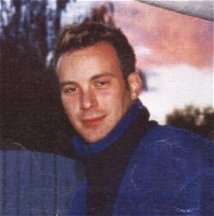
Julian Monette
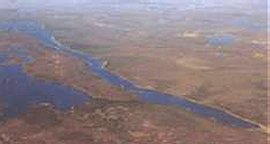
Frost Lake 59o 19’ N, 103o 58’
W
Named in Memory of Gordon Frost
Killed in action Nov. 27, 1943. Age 21
|
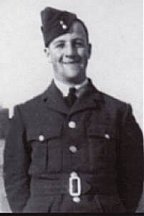
Gordon Frost, Brandon Manning
Depot March 1941
|
EDITORS REPORT
You will see from the above articles on #7 BR Squadron,
that your Editor has had a severe bout of writer’s diarrhoea. This reminds
me of when the Ex-Air Gunner’s Association of Canada was formed in March
1983 and the quarterly newsletters was mailed out. One of the founding
Members, Jim Patterson, assisted Charley Yule, Secretary, Keeper of the
purse, Editor, as Associate Editor.
On one occasion Jim wrote a lengthy article and ended
with the following:
“So that is one adventure I had during my war winning
years, and if some of you do not send me your stories, I’ll tell you another
- YOU HAVE BEEN WARNED!!”
There are a thousand stories out there. Lets share them.
If you are looking for military related books a reliable
contact is
http://stonebooks.com
More Bar memorabilia:
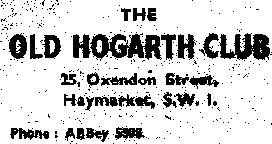
OK, how many can remember this watering hole?
Through my Ryze site http://www.ryze.com/go/gopher
I met a lady in California who operates a doughnut shop. Her Dad was a
Ham Operator and, when she was six years of age, he taught her Morse Code.
When she saw that I had been a Wireless Operator she sent me a page letter
in Morse Code. I was amazed how fast it came back. I guess it is like riding
a bike, you never forget. We have exchanged a couple of letters in code.
Comments by Pat O’Buck who served in the Royal Canadian
Corp of Signals during the war:
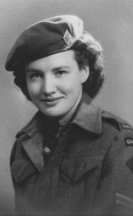
Corporal Pat Moyles
Now O’Buck
(All fan mail to be channelled through the Editor.)
“I read morse at 30 wpm at one time and now could be up
to 15 in short order. I have had my ham license since the mid-seventies.
It is up for renewal this year but I may not bother. Now it is mandatory
to provide a Social Security number and after all these years, I don't
see the point. Pat”
Life, after all, is just a matter of making memories.
So lets share some of our memories before they are no more.
Until the May/05 Page – keep well.
John & Doreene Moyles - Short Bursts Editors
Sept. 1989 - ____ .
.
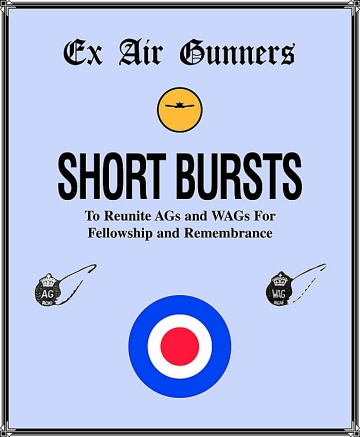

![]()
![]()
![]()
![]()
